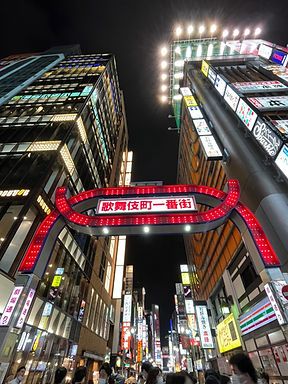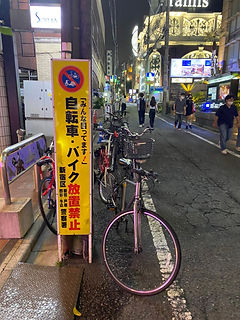
types of public signboards
Public Signage
by Hayato
This page will discuss the various types of public signboards and analyze its’ role / significance in the context of Kabuki-cho.
public signboards
Signboards which are issued by public organizations (e.g., government, district bodies…) that are not utilized for business / profit intentions
Introduction
Mathur discusses in his article, ______, the intentions of placing signboards in public areas;
“Their main purpose is to inform, stimulate, motivate, convince, and lead viewers to a to a product or service, and to create in the mind of the viewer a positive attitude towards the message being propounded.” ()
Thus, every signboard should have a particular intention which aims to influence the behavior of the public. Through continuous fieldwork, we were able to observe an immense number of public signboards placed in the Kabuki-cho district. Thus, we have categorized them into mainly __ categories, in which each varies in its’ purpose and role.
TOURISM
Kabuki-cho is one of the largest red-light districts in Tokyo; prominent for its’ providence of tourism and other synonymous services. However, besides such businesses, entertainment facilities and restaurants are also available; which the district aims to bring in tourists from all generations. Accordingly, signboards which seem to promote such aspects of Kabuki-cho were observed.
The most obvious example would be the Ichiban-gai gate, which is located around the intersection between Ichiban-gai and Yasukuni-dori. The official name is the 歌舞伎町一番街アーチ(Kabuki-cho Ichiban-gai Arch) and it is composed of 600 LED light bulbs as well as a solar light panel which is intended to be utilized for emergency cases. Considering its’ size, red neon-lighting and geographical location between Shinjuku station and the district, such features enable the gate to function as a significant landmark; gathering attention from the viewers.
Another prominent example would be the ‘I ♡ 歌舞伎町 Kabuki-cho’ signage placed on the exterior of the building in front of TOHO Cinemas. Similar to the Ichiban-gai gate, the signage is composed of red neon lighting. Moreover, the design seems to resemble the famous ‘I ♡ NYC’ figure, which can suggest how Kabuki-cho is making its’ way to become a tourist hotspot in Tokyo.

Kabukicho Ichiban-gai Arch

I LOVE KABUKI-CHO
歌舞伎町 SIGNAGE
CREATING A FLASHY CITY SCAPE
GODZILLA ROAD SIGNAGE

SAKURA-DORI SIGNAGE

When one visits Kabuki-cho, the first thing they notice would probably be its’ neon lighted, flashy atmosphere, from the vast number of electronic signboards and signages placed in the district. Similar characteristics are also often observed in other districts where nightlife is a significant feature. For instance, Las Vegas, prominent for its’ casino and other nightlife entertainment also has a similar flashy atmosphere which resembles Kabuki-cho. Considering this characteristic to be one of the features for tourism, signboards utilized for tourism may overlap with those which function to create the flashy city scape of the district.
The ‘Godzilla road’ signage is located alongside Central road. In the picture on the right, the signage is lighted in blue, however, the color scheme continuously changes, creating a flashy impression to the viewers. Despite the official name of the street to be ‘Central road’, the signage seems to be emphasizing the name of ‘Godzilla road’, which suggests the strong correlation between TOHO Cinemas and the district as a whole.
A similar signage is also located near the intersection between Yasukuni-dori and Sakura-dori. This Sakura-dori signage is lighted blue in this picture, however, similar to the Godzilla road signage, the coloring constantly changes as time passes by. Such use of lighting would be unnecessary if the signboard was only to indicate the name of the street. Therefore, the intentions of embracing the flashy city scape of Kabuki-cho can be suggested.
SECURITY/MAINTAINING CIVIC ORDER
On one side, Kabuki-cho can be represented as a tourism hotspot with its’ bright atmosphere of the district. On the other hand, there are concerns regarding civic order as well. The crime rate of Kabuki-cho is listed as the worst of all districts in Shinjuku ward with 38.8% (average of other districts is 1.5%). Therefore, the necessity to restrict crimes and extralegal activities by the government is vital in order to take control of the civic order.
Kyakuhiki
Kyakuhiki’, which translates to ‘Catch’, can often be observed in Kabuki-cho. Kyakuhiki 客引きindicates the action (or the actor), of inviting someone over to their store as a customer. Many kyakuhiki’s are often correlated with bottakuri (—> ripped off stores) and such actions on public streets is illegal in Japan. Nevertheless, such are still frequently experienced in Kabuki-cho and security officers (Karen, Note 3 (F3)) were present in order to have them under control. Besides, public announcements (Moe Shiojiri, Note 10 (F4)) are repetitively played, asking the public to be aware of sketchy kyakuhiki. Likewise, signboards warning the public from such people can also be commonly observed.

in Chuo-dori

Around Sakura-dori

In Moa 3rd St.

In Moa 3rd St.
No Littering
Littering is also commonly seen (Taiga, Note 1 (F2)) in Kabuki-cho. For instance, empty cans and plastic bottles are thrown in the side of the streets despite a fair amount of recycle bins being placed in the district. Littering is against the Violence of the Waste Management Law and likewise, signboards asking people to avoid littering is commonly seen in Kabuki-cho.
No Smoking
Regulations on outdoor smoking differ, depending on the district one is placed in. Shinjuku ward is having designated outdoor smoking sections, where one is found punished if they are caught smoking outside these areas. Nevertheless, cigarette butts are often seen in streets outside these designated areas, indicating that outdoor smoking is a common action observed in Kabuki-cho. Likewise, signboard calling the public to smoke in designated areas are placed in many locations within the district.

signboard (flag) taken in east-exit

signboard taken in Sakura-dori

signboard taken in the host club district

signboard taken in the host club district
No Parking
While differences among areas are present, street parking is often prohibited unless one is granted an official permission to do so. An absurd amount of bicycles (Reio Nakajima Note #2 (Fieldnotes 2)) were parked in front of buildings in some of the areas within Kabuki-cho. Moreover, many of them seemed to be parked despite the placement of signboards (Hayato, Note 1 (F8)) asking the public not to do so. Nevertheless, these signboards were frequently found through the fieldwork.
Conclusion
As Mathur discussed in his article, each signboard would ought to have its’ respective purpose and message with the intention of influence viewer behavior in a certain way. With that in mind, different categorizations of signboards were possible despite falling under the common umbrella of ‘public signboards’, in terms of its’ purpose, role and message. However, similarities amongst signboards of different categories / differences within the same category are also observable, which will be discussed in different pages.
.png)